L.P.G is the most convenient and clean fuel for domestic use and is very popular in these days. The LPG stove industry is about 36 years old and is mainly concentrated in the small-scale sector. LPG is an exceptional energy source due to its origin, relative advantages and applications. No wonder LPG is known as The Ideal Fuel for Modern Living. With global availability, environmental benefits, its natural by-product origin, transportation flexibility and diverse application, LPG plays a pivotal role in the transition towards a more secure, sustainable and competitive energy model. Considering the limited fossil fuel resources, energy conservation, environmental issues, increase in the demand on LPG in near future, it is a necessary to explore the ways to further improve the thermal efficiency and the emission characteristics of the existing LPG cooking stoves. In the present work, various works dealt with research in increasing thermal efficiency of stoves using different fuels, and different burners are studied. Various parameters affecting thermal efficiency of a burner are determined.
Keywords |
| LPG cooking burner, performance Analysis, efficiency |
INTRODUCTION |
| A gas burner is a device to generate a flame to heat up products using a gaseous fuel such as acetylene, natural gas or
propane. Some burners have an air inlet to mix the fuel gas with air to make a complete combustion. Acetylene is
commonly used in combination with oxygen. It has many applications such as cooking, soldering, brazing and welding,
the latter using oxygen instead of air for getting a hotter flame which is required for melting steel. For laboratory uses a
natural gas fired Bunsen burner is used. For melting metals with melting points of up to 1100 °C such as copper, silver
and gold a propane burner with natural drag of air can be used. LPG stove is a relatively simple appliance for direct
combustion. Its burner is a premix and multi-holed burning ports type, and operates at atmospheric low-pressure. A
typical gas stove consists of gas supply tube, gas tap/valve, gas injector jet, primary air opening(s) or regulator, throat,
gas mixing tube/manifold, burner head, burner ports (orifices), pot supports and body frame. |
| Center for Energy Studies, Institute of Engineering Tribhuvan University, Pulchowk, Lalitpur,Nepal [1] have
found out the efficiency of biogas stove. For comparison, efficiency of LPG (Liquefied Petroleum Gas) and kerosene
stove (pressure type and wick type) was also studied. |
| Efficiency of a stove could be categorized as burning efficiency and overall efficiency. Burning efficiency of a
stove accounts for the capacity of that stove in terms of combustion of fuel, in other words ability of the stove to
change the energy from fuel to heat energy is related with burning efficiency. The ability of the stove to change the
energy from fuel into the energy gained by the specimen such as water, rice, milk etc is termed as overall efficiency of
the stove. Generally efficiency of stove is indicated by overall efficiency. |
| Other evidences on calculation of efficiency of different types of stoves were studied for their research.
Overall efficiency of stove depends upon different conditions such as temperature, pressure, wind speed, specific heat
capacity of the vessel, bottom and overall shape of vessel, weight of vessel, size of vessel and amount of specimen.
Thus different tests for efficiency could yield different results of the same stove. Calorific value (MJ/kg or kJ/ Lit) of
the fuel is the input energy for stove and they accounted it in course of efficiency measurement. |
| Methodology applied by them was as follows [1]-[11] |
| Overall efficiency = hc * hr |
| Where, |
| hc = combustion efficiency |
| hr = Heat transfer efficiency |
| Overall efficiency = Percentage of chemical heat that enters the pot. |
| In their study methodology used was - efficiency of cook stoves was determined by calculating the heat
gained by the water subjected for heating and amount of fuel consumed during this process. Heating of water from
initial water (subjected to boiling) temperature T|°C to boiling point is termed as High Power Phase (HPP). During this
phase water in vessel gains energy from fuel with the help of burning stove and that value of energy is equivalent to
energy required to raise the temperature of that mass of water from T|°C to boiling point. In Low Power Phase
predetermined weight of water at boiling point was subjected to boil for five minutes and energy gained by this water is
calculated by multiplying latent heat of vaporization of water and mass of vaporized water. Fuel consumed during each
process is the input energy for these phases. Overall efficiency is calculated by dividing output energy by input energy.
In this process they have included the heat gained by vessel in which water was boiled. Heat gained by vessel = Mv * |
| Sv * (Tb - Ti) Joule |
| Heat gained by water in HPP= Mw * Sw * (Tb - T,) Joule |
| Heat gained by water in LPP = (Mstesm *Lwboil) Joule |
| Energy of fuel = (Mfule * Kfuel) Joules |
| Where- |
| Mv = Mass of vessel |
| Sv = Specific heat capacity of vessel |
| (Tb – T1) = Change in temperature (from Tl to boiling Point) |
| Mw = Mass of water |
| Sw = Specific heat capacity of water |
| Msteam = Mass of evaporated water during LPP |
| LWboil = Latent heat of boiling of water |
| Mfuel = Mass of consumed fuel |
| Kfule = Calorific Values of Fuel |
| Efficiency (overall) ={MW*SW* (Tb - T,) + (Msteam *Lwboil) + Mv * Sv * (Tb - T,) } / ( Mfule * Kfulel) |
| Efficiency (overall) = {Heat gained by water in HPP + Heat gained by water in LPP
+Heat gained by vessel} / {Quantity of fuel consumed * unit calorific values of fuel}. |
Constants taken for calculation: |
| ■ Specific Heat Capacity of Water = 4190 J/kg °C |
| ■ Specific Heat Capacity of Aluminium = 125 J/ kg °C |
| ■ Calorific value of Kerosene = 42 MJ/kg |
| ■ Calorific value of LPG = 44 MJ/kg |
| ■ Calorific value of biogas = 22 kJ/Lit |
| They conclude their work with following observations- |
| The efficiency of a given stove is not constant. It could vary on the basis of surrounding conditions and quality of fuel
used. A high value of efficiency could be obtained under controlled conditions. But in practice this value is normally
lower than the value found in the controlled laboratory condition. The efficiency of stove depends upon following
conditions: |
| a. Environmental conditions, such as wind, temperature, pressure |
| b. Shape, specific heat capacity and weight of vessel. |
| e. Burner size of stove and size of bottom face of cooking vessel. |
| d. Energy content of fuel and quality of fuel. |
CASE STUDIES |
| 1.Walter M. Berry, I. V. Brumbaugh, G. F. Moulton, and G. B. Shawn, in their first part of paper presented the
design of gas burners. They developed an atmospheric gas burner. They develop the arrangement of apparatus and
method of testing. For their work they studied the theory of flow of gas through different types of orifices, the
principles governing the rate of injection of air into the burner, the design of the injecting tube, the rate of consumption
of burners of different port areas, and the effect of adjustment of the air shutter. The rate of discharge of gas orifices of
different types was found to vary greatly with a variation of the angle of approach and with the length of channel or
tube of the orifice. It has been found that for any given burner the ratio between the momentum of the gas stream and
the momentum of the stream of the air-gas mixture entering the burner is always a constant, and this relation enables
one to calculate readily the effect on the volume of air entrained when the gas pressure, gas rate, or specific gravity of
the gas is changed. |
| For their work they tested performance of burner on various strategies. Various types of burner orifice were
designed and optimized. Similarly different models of injection tubes were designed. Orifice position also changed and
the optimum injector was selected. A relation between Burner tube and burner ports was used to find out the
characteristics of satisfactory burner. With smaller size port, it was possible to turn the gas lower without causing a
flash back. The secondary air having a greater cooling effect on the small flames is reducing the velocity of flame
propagation. |
| They found an important co- relation between the area of the throat of the injecting tube and the area of the
burner. The results of the tests show that the area of the injector throat should be about 43 per cent of the area of the
burner ports. They provided a guideline to choose a burner for any conditions- there has been compiled a series of
tables, based on the preceding experimental work and calculations, which show the rate of consumption of various
sizes of burners for different pressures and air-gas ratios. Since the rates of consumption of burners without injecting
tubes increase with increasing port area, it will be difficult to make up tables that will be generally applicable for the
various types of burners. With an injecting tube the rate of consumption of a burner is increased so much that it is
necessary to have the pipe larger in proportion to the port area, otherwise the velocity past the first ports is too great to
give good results. Burner with simplicity, low cost, and reliability the well adapted for domestic and most of the
smaller industrial purposes. If their range is widen, such burners can be operated efficiently and without adjustments,
and design them to meet the needs of any particular purpose, it will make gas fuel much more valuable and will
broaden its field of application. |
| 2. Obada David Olubiyi has designed constructed and evaluated performance of biogas burner. The work geared
towards modification and the improvement of biogas burners and their efficiency. The performance of the stove was
evaluated by the process of boiling water. The efficiencies of the stove in water boiling and rice cooking were 21%, and
60% respectively. Also, flue gas analysis was carried out to establish the emissions of the stove. The combustion
efficiency of the stove recorded by the flue gas analyzer was 86.9%. |
| For concerned work, Obada David Olubiyi focuses on design details of Gas flow rate through injector, Injector
orifice/jet design, throat design, Burner port design, secondary air supply, flame stabilization, pot supports, and
specification of fuel (Biogas). Perfect material selection for different components was next prime important task. |
| Prime design parameters were- |
| •Gas inlet pipe should be smooth |
| •Diameter of the jet (do) |
| •Length of the mixing pipe (L) |
| •Number and diameter of flame port holes (dH) |
| •Height of the burner head. (H) |
| Design considerations- |
| •Specific gravity of gas |
| •Calorific value |
| •Volume of biogas produced |
| •Composition of the gas produced |
| •Gas pressure |
| •Flame speed (velocity) |
| After implementation of different designs parameters, a burner is fabricated, and evaluated for performance. Flue gas
analysis also performed. Following results were obtained - |
| •The potential of this stove can be maximized by improving the air/gas regulating mechanism. |
| •The percentage of O2, CO2 and excess air were constant for the flue gas analysis done on the three (3) burners
tested. This was because the machine worked on some preset values inputted during calibration for different
kind of fuel. |
| Further work will be to- |
| 1. Affect the air/gas regulating mechanism by improving the method of moving the injector into and out of the air/gas
mixing chamber |
| 2. Design and construct a 2-flame burner deriving from the experience of the single-flame burner evaluated in this
research. |
| 3. Apinunt Namkhat and Sumrerng Jugjai investigated the effects of changes in the combustion air temperature on
the primary aeration and flame structure for self-aspirating burners. They performed studies for with and without
preheat case of combustion air. They observed that the level of primary air entrainment is increased with increasing the
heat input. The preheated case gives a lower primary aeration than the without preheat case, because the preheating
effect will make the fluid in the mixing tube has more viscosity. A yellow tip flame also occurs with increasing the
preheated air temperature due to decreased primary aeration. It will be helpful in designing a high-performance burner
in the future. |
| For their work LPG is used as a fuel in the experiment, the oxygen sensor was used to measure oxygen concentration
with an accuracy of about 0.05%. An uncertainty analysis was carried out with the method proposed by Kline and
McClintock, Using a 95% confidence level, the maximum and minimum uncertainties in the presented primary aeration
were found to be 3.3% relative and 1.6% relative, respectively. |
| A set up was installed for primary aeration measurement using the oxygen sensor which is applied for both with and
without preheat cases. It was composed of a self-aspirating burner. |
| For the preheat case, a similar experiment was performed using the same procedure as described for the without preheat
case, but with a primary air preheat. They select four preheated air temperatures (Tpre) for the experiments (50
°
C,
100
°
C, 200
°
C, and 300
°
C). The static pressure was measured by the water manometer. Meanwhile, the flame images
are also captured with a digital camera. |
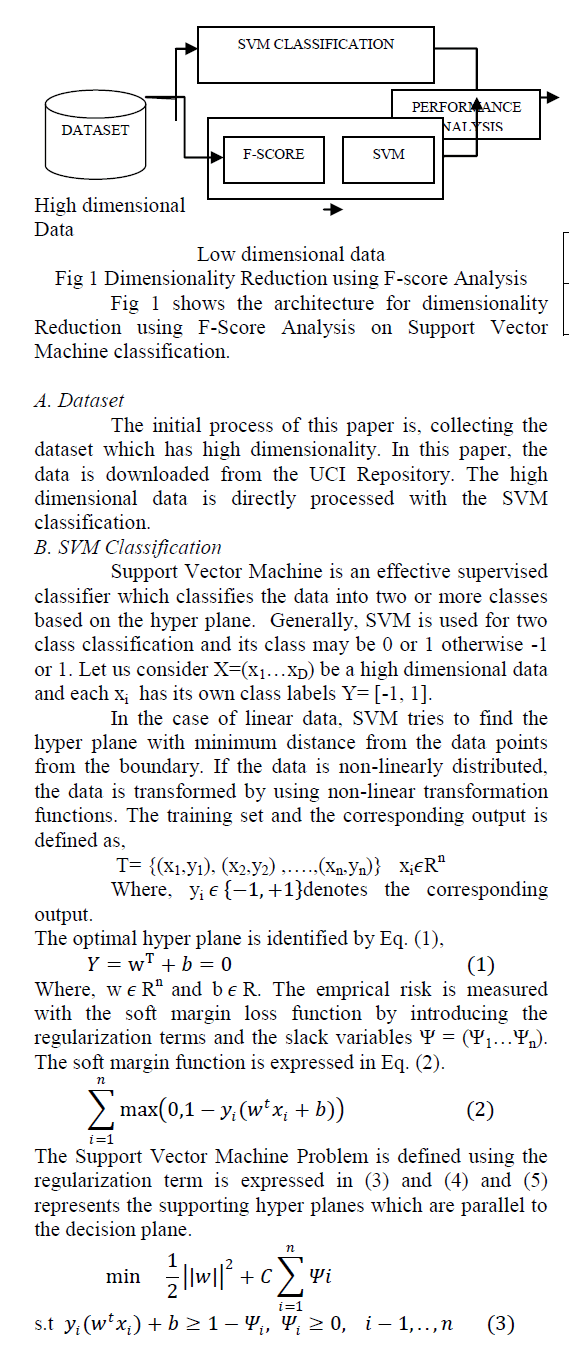 |
| Apinunt Namkhat and Sumrerng Jugjai got following results- the primary aeration in both cases rapidly
increases at the early stage with an increasing heat input. After that, the primary aeration is stable and no longer
dependent on the heat input, due to limitations of mixing tube and burner port sizes. The primary aeration decreases
with an increasing preheated air temperature. |
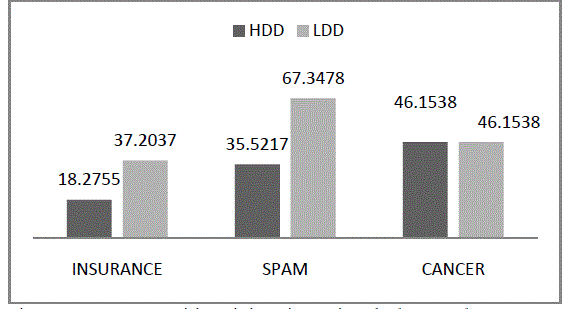 |
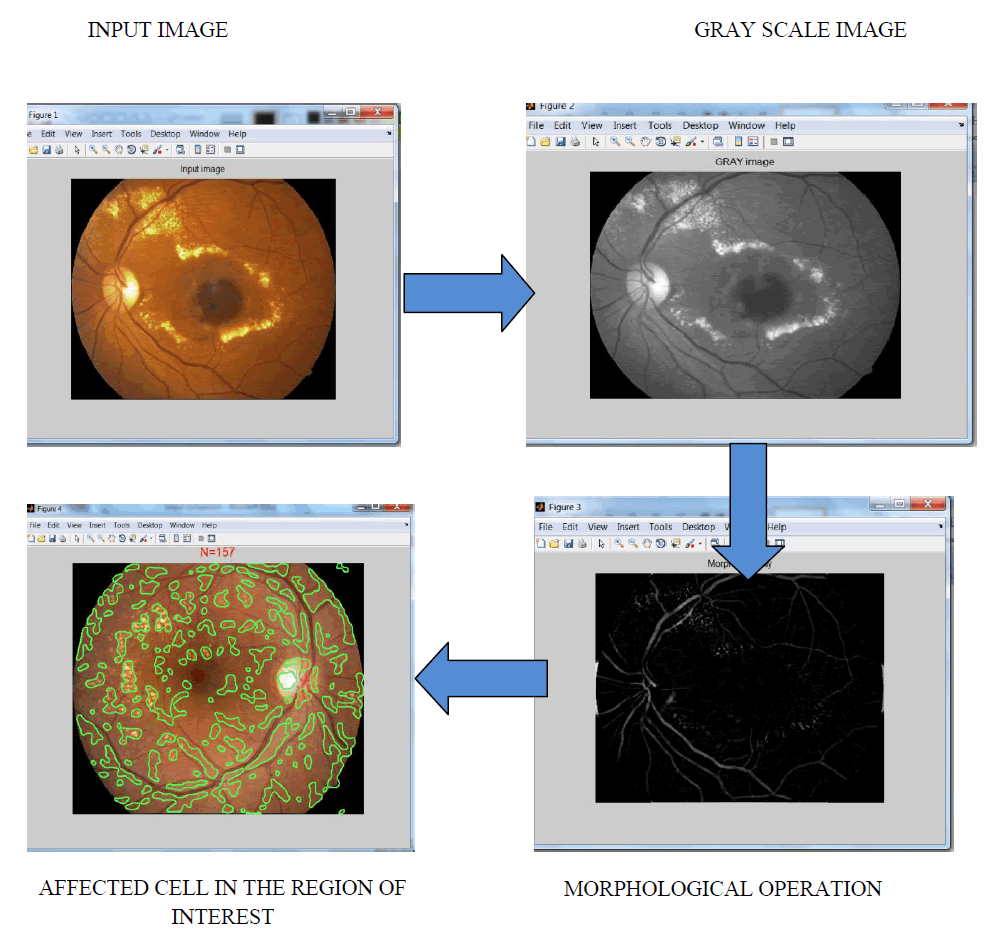 |
| The preheated air temperature of T= 300
°
C gives about a 14 percentage point (33% relative) lower value than
that of the without preheat case, because the preheating effect causes expansion of the mixture and an increase in its
viscosity. |
| The pressure distribution for the preheat case is greater than that of the without preheat case. The pressure distribution
increases with the preheated air temperature |
| For Flames- |
| The flame image of a self-aspirating burner in the open environment for the without preheat case-, The flame structure
of a partially aerated burner has two distinct regions: the inner cone flames and the outer cone flames. The inner cone
flames are the rich premixed flames burning with the entrained primary air, while the outer cone flames are the nonpremixed
flames due to the combustion of the unburnt fuel and intermediate species with the secondary air. It was
observed that a yellow tip flame occurs in the inner cone flames as heat input decreases. On the other hand, when
further increasing heat input, the inner cone flames are greenish-blue in colour showing the abundance of CH and C
2
in the flames. However, the yellow tip flame appears in the outer cone flames, because the mainly secondary air cannot
entrain from the surrounding above the burner plane. Flame appearance and flame stability are affected by thermal
input (flow rate of fuel) and primary aeration. It was found that the increase of thermal input leads to the increase of
flame height, because of the high velocity of the gas mixture. |
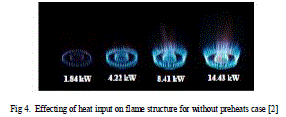 |
| Flame images obtained with the different preheated air temperatures- yellow tip flame occurs with increasing the
preheated air temperature due to decreased primary aeration. |
| The high preheated air temperature is responsible for low primary aeration and an increase in the burning velocity.
Thus, the flame height found is almost constant irrespective of the temperature of preheated primary air. |
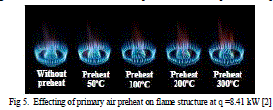 |
| They conclude their work with – The Primary Aeration level in both with and without preheat cases rapidly increases at
the early stage with increasing heat input. After that, it is stable and no longer dependent, due to limitations of mixing
tube and burner port sizes. Due to decreased primary aeration, a yellow tip flame occurs with increasing the preheated
air temperature. |
| CO emissions level increases, due to incomplete combustion However, the flame height is almost constant due to
increased burning velocity. They recommend, in order to design a high-performance burner in the future, the
preheating effect can be taken into consideration in designing the mixing tube so as to obtain an accurate primary
aeration. |
| 4. V.K. Pantangi, Subhash C. Mishra, P. Muthukumar, Rajesh Reddy work on the performance tests of a PRB
(porous radiant burner) used for LPG (liquefied petroleum gas) domestic cooking stoves. Combustion in porous
medium has attracted more attention due to its clean and high combustion efficiency. For getting these advantages the
burner was constructed with two-layer porous media. The combustion zone was made up of silicon carbide, and
alumina balls were used to form the preheating zone. For a given burner diameter, the performances of the burner, in
terms of thermal efficiency and emission characteristics, were analyzed for different equivalence ratios and thermal
loads (wattages). The water boiling test as prescribed in the BIS (Bureau of Indian Standard): 4246:2002 was used to
calculate the thermal efficiency of both the conventional LPG cooking stoves and the PRB. The maximum thermal
efficiency of the LPG cooking stoves with a PRB was found to be 68% which is 3% higher than that of the maximum
thermal efficiency of the conventional domestic LPG cooking stoves. The axial temperature distribution in the burner
showed that the reaction zone was close to the interface of the two zones and at a higher thermal load, it shifted towards
the downstream. The surface temperature of the PRB was found to be uniform. |
| The CZ (combustion zone) of the two-layer PRB was made of SiC (silicon carbide) porous matrix. Al2O3 (Alumina)
balls of 5 mm diameter form the PZ (preheating zone). The porosity of PRB was 90% and its thickness varies from 1.5
cm to 2.0 cm. The burner casing was fabricated using alumina powder and sodium silicate binder. To sustain high
thermal stresses, casing was sintered at high temperatures. The PRB consists of a combustion zone, a preheating zone, a
wire mesh to support the preheating zone, a burner casing and a mixing tube made up of Teflon. The experiments were
performed with different diameters and thicknesses of the combustion zone. 5 different types of burners were used in
this investigation. These burners are named as B6, B7, B8, B9, and B10. The experimental set-up used for testing the
performance of PRBs .The fuel-flow and air-flow rates were monitored using the rotameters with control valves. The
compressed air and the LPG at a pressure of 3.0 kN/m2 were taken through their respective rotameters to the mixing
pipe. The water boiling test as per the guidelines of the BIS: 4246:2002 was employed to measure the thermal
efficiency of the LPG cooking stoves. The distance between the burner surface and the bottom of the pan, as per BIS
was kept at 5.0 cm. |
| The CO and NOX emissions were measured using the TESTO 350 XL portable flue gas analyzer. The sampling was
done as suggested in the BIS: 4246:2002. |
| The maximum thermal efficiency in each case has been observed at different equivalence ratios, and this is for the
reason that for different burners, for the flameless condition, the air requirement was different. For a given burner at a
given wattage, the thermal efficiency is higher at lower equivalence ratio and found to decrease with increase in
equivalence ratio. For example, for B6 burner at 1.3 kW, efficiency decreases from 63% to 50%, when the equivalence
ratio increases from 0.41 to 0.51. |
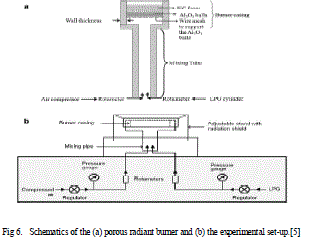 |
| For the two-layered PRB, the investigation was made for five different combinations in terms of thicknesses
and diameters of the combustion zone made of SiC. Axial and radial temperature istributions of the burner were
measured for different wattages and equivalence ratios. For all the burners thermal efficiencies and CO and NOX
emissions were also obtained. The axial temperature measurement revealed that at higher wattages, the reaction zone
shifted downstream of the burner. The radial temperature was found to be more uniform for higher wattages, which can
be a desirable feature of any burner. The maximum thermal efficiency of the B8 burner was about 68%, which is 3%
higher than the maximum thermal efficiency of the conventional LPG domestic cooking stoves. The thermal efficiency
of the PRBs was found to increase from 62% for B6 to 68% for B8 burner. The maximum thermal efficiencies of B8
and B9 burners were found to be almost the same (68%). However, the maximum thermal efficiency of B10 burner was
found to decrease due to the higher radiation heat loss. The CO and NOX emissions of the PRBs were in the range of
25e350 mg/m3 and 12e25 mg/m3, which are much lower than the corresponding. values (CO: 400e1050 mg/m3 and
NOX: 162e216 mg/m3) for the conventional LPG domestic cooking stoves. |
| 5. N. K. Mishra, P. Muthukumar, Subhash C. Mishra, implements the concept of Porous Medium Combustion
(PMC) in to porous radiant burner (PRB). In PMC, the combustion of fuel and air mixture takes place inside a matrix
of open cavities in the presence of an inert solid surface. The porous matrix has high thermal conductivity and high
emissivity as heat transfer takes place through conduction and radiation. They conduct performance tests on PRB used
for medium - scale cooking applications of capacity 5-10 kW was presented. |
| The PRB chosen for the study was SiC-based porous burner. Liquefied petroleum gas (LPG) was used as a
fuel. Effects of different heat inputs in the range of 5 - 10 kW on the thermal efficiency and emission levels of PRB are
investigated. For the conventional LPG burner of 5-10 kW capacity, the measured value of thermal efficiencies is in the
range of 30-40%, and the CO and NOx were in the range of 350-1145 ppm and 40 - 109 ppm, respectively. These
emissions levels were well above the world health organization standards. Within range of parameters tested, the SiCbased
PRB yields the maximum thermal efficiency of about 50%, which is about 25 % higher than the conventional
stoves. |
| In conventional combustion devices are free flame, with convection as the only mode of heat transfer. Hence
conventional combustion devices less efficient and result in increased CO and NOx emissions due to poor the poor heat
transport. The LPG cooking gas burner is one such device that goes well with this category of high emission levels and
low thermal efficiency. To overcome the difficulties of the free flame combustion, another means of combustion was
discovered known as porous medium combustion (PMC). PMC offers high power density, high power dynamic range
and very low NO and CO emissions, also the high levels of heat capacity, conductivity and emissivity of the solid
matrix, compared to a conventional combustion devices. |
| The fuel and air flow rates were monitored using the coriolis flow meters with suitable valves. Air–fuel mixture moves
to the burner through a mixing tube made of Teflon. Adjustable stand has been attached with a radiation shield. The
PRB used for the work was based on two-layered PMC, a combustion zone and a preheating zone. Combustion zone
was formed with high porosity (90%), highly radiating SiC porous matrix, and the preheating zone consists of low
porosity (40%) ceramic matrix of 120 mm diameter. Inside the burner casing, a wire mesh is provided to support the
ceramic block. The burner casing was fabricated at IIT Guwahati using alumina powder and sodium silicate binder. |
| Thermal efficiencies of the LPG cooking stoves were estimated by conducting the water boiling test as per the
guidelines described in Bureau of Indian Standard (BIS):4246:2002. To compare the thermal efficiencies of
conventional burners with PRB, a market survey was carried out to get the various types of burners used in
conventional commercial LPG cooking stoves. The efficiencies and emissions of PRB and conventional burners were
calculated using the same procedure. The CO and NOx emissions were measured using TESTO 350 XL portable flue
gas analyzer. The sampling was done as suggested in the BIS: 4246:2002 |
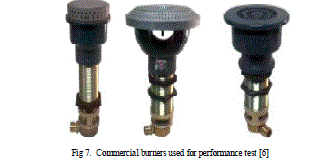 |
| Thermal efficiency was measured for conventional burners at different thermal loads and it was found in the range of
30-40%.Whereas thermal efficiency for PRB was found in the range of 40-50%. For the chosen configuration of the
PRB, with increase in the thermal load, the observed trend of lower efficiency was attributed to the fuel rich mixture
and increased heat loss. |
| The CO and NOx emissions from the conventional burner and the PRB were tested for exhaust gas analysis for
different thermal loads. At all thermal loads, both CO and NOx emissions were found lower for the PRB. |
| It was concluded that thermal efficiencies of the PRB gradually decreased with increase in power intensity.
PRB with 5 kW thermal loads the maximum thermal efficiency of about 50%, which was about 25% higher than the
efficiency of the conventional burner. At the thermal load of 10 kW, the PRB gives the maximum improvement in
thermal efficiency of about 34.3 %. The measured emissions of CO and NOx were much lower than the conventional
commercial burner. |
| 6. Mohd. Yunus Khan1 and Anupriya Saxena, focused their work on finding the effects on using different design
burner heads on the performance of LPG cooking stove. Burners of different material were used to study the effects of
burner material on LPG stove performance. It was experimentally found out that thermal efficiency of stove using flat
and flower face brass burners were higher as compared to regular cast iron burner. |
| The burner head was removed and replaced by different design. Different burner head designs used in this work.
Thermal efficiency was found out as per the BIS. It is observed that thermal efficiency of LPG stove improves by using
flat and flower faced burners. When flower face burner was used, thermal efficiency of LPG stove was found to
improve. The thermal efficiency of flat face brass burner was found to be maximum of 58%. |
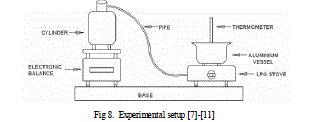 |
| The thermal efficiency of LPG stove for regular cast iron burner was found to be 48%. When flat and flower face
burners were used, thermal efficiency of LPG stove improved. When flat face brass burner was used maximum
thermal efficiency of 58% was achieved. While thermal efficiency of 50% was observed when face brass flower burner
was used. Further, it was experimentally found out that thermal efficiency of LPG stove using regular brass burner was
4% higher as compared to regular cast iron burner. The technique of replaced of burner head is simple and safe. It can
be easily implemented in domestic LPG stove for fuel conservation |
| 7. Catharine Tierney, Susie Wood, Andrew T. Harris and David F. Fletcher, implement convective and radioactive
heat transfer models to the commercial computational fluid dynamics (CFD) code ANSYS CFX, they describe the
interaction between the porous solid and the fluid. In addition a relatively detailed skeletal chemistry mechanism was
incorporated and a stiff chemistry solver was used to provide an accurate assessment of the combustion behavior. The
porous medium produces improved efficiencies, reduced pollutant emissions, an enlarged stable operating power range
and, importantly, the ability to operate at concentrations near or below the lower flammability limit. |
| They also developed the numerical model, added gas mixture properties to this model and apply conductive,
convective and radiant transfer within porous domain. |
| Fixed flux boundary conditions were applied for an analytical validation of the heat transfer equations. In addition, the
validity of the chemical mechanism in the numerical model was confirmed using CHEMKIN (Reaction Design, 2006).
This validation was accomplished by imposing a CFD fluid temperature output profile onto a plug flow reactor in
CHEMKIN under the same inlet conditions. The CFD profile was obtained without gas transport in accordance with
the plug flow reactor conditions. Comparisons of the concentration profiles from CHEMKIN with those from the CFD
verified the correct implementation of the chemical mechanism within the CFD model. |
| The model results indicated that the energy balance of the system determined the combustion performance and
flame location. This balance was directly influenced by heat recirculation within the solid matrix and by solid to fluid
convective transport. |
| 8.Pankaj P. Gohil and Salim A. Channiwala, Perform the analysis of conventional LPG cooking stove, found 66.27%
thermal efficiency. Emission test and water boiling test were conducted according to IS 4246:2002. |
CONCLUSION |
| Various works related with performance and efficiency of the conventional cooking stoves was studied. Some
experiments were based on other fuels such as kerosene and biogas. But basic objective for the research was found to
be same. In all the case studies, a common factor is observed which affect the performance of a stove severely; it is a
burner of any stove. Hence we have to improve the efficiency of a stove, we must focus on burner specifications,
designs and its materials. |
| 1. Air preheating effect can be taken into account for better efficient burners. |
| 2. If Porous Medium is constructed in a burner, its emission of CO and NOx are found to be lowered compared to
conventional burners. Also the thermal efficiency has been increased. |
| 3. Burner material and construction also affects the performance of a stove. Brass burners found more efficient than
cast iron burner. Similarly flat faced burner is more efficient than face flower. |
| 4. The results show that the area of the injector throat should be about 43 per cent of the area of the burner ports. |
References |
- Center for Energy Studies Institute of Engineering Tribhuvan University Pulchowk, Lalitpur July 2001, “Efficiency Measurement of Biogas, Kerosene and LPG Stoves”
- Walter M. Berry, I. V. Brumbaugh, G. F. Moulton, and G. B. Shawn “Design Of Atmospheric Burners” Technologic Papers Of The Bureau o Standards, September 6 1921.
- Obada David Olubiyi, “Design, Construction And Performance Evaluation Of A Biogas Burner”, An Msc Thesis Submitted To The Postgraduate School, Ahmadu Bello University Zariain Partial Fulfilment Of The Requirements For The Award Of Masters Of Science (M.Sc) Degree In Mechanical Engineering
- ApinuntNamkhat and SumrerngJugjai, “ The Effect of Primary Air Preheat on the Primary Aeration of a Self- aspirating Burner” The First TSME International Conference on Mechanical Engineering 20-22 October, 2010, UbonRatchathani
- V.K. Pantangi, Subhash C. Mishra, P. Muthukumar, Rajesh Reddy, “Studies on porous radiant burners for LPG (liquefied petroleum gas) cooking applications” Energy 36 (2011) 6074e6080
- N. K. Mishra, P. Muthukumar, Subhash C. Mishra, “Performance Tests on Medium-Scale Porous Radiant Burners for LPG Cooking Applications” International Journal of Emerging Technology and Advanced Engineering Volume 3, Special Issue 3: ICERTSD 2013, Feb 2013, pages 126-130.
- Mohd. Yunus Khan and AnupriyaSaxena, “Performance Of LPG Cooking Stove Using Different Design Of Burner Heads” International Journal of Engineering Research & Technology (IJERT) Vol. 2 Issue 7, July – 2013.
- Catharine Tierney, Susie Wood, Andrew T. Harris and David F. Fletcher, “Computational Fluid Dynamics Modelling Of Porous Burners” Seventh International Conference on CFD in the Minerals and Process Industries CSIRO, Melbourne, Australia 9-11 December 2009
- Mohd. Yunus Khan and AnupriyaSaxena, “Performance of Insulated LPG Burner with Ball Bearings as Porous Medium”, PJST ISSN: 2249-5487.VOl.2 (1), Jan-June-2012
- Pankaj P. Gohil and Salim A. Channiwala, “Experimental Investigation Of Performance Of Conventional LPG Cooking stove”, Fundamental J. Thermal Science and Engg. Vol. I. Issue 1, 2011, Pages 25-34.
- Scheme Of Testing and Inspection for Certification Of Domestic Gas Stoves For Use With Liquified Petroleum Gases According To Is 4246:2002 (Fifth Revision) (Including Amendment No. 1 & 2), DOC: STI/4246/13April 2010.
|